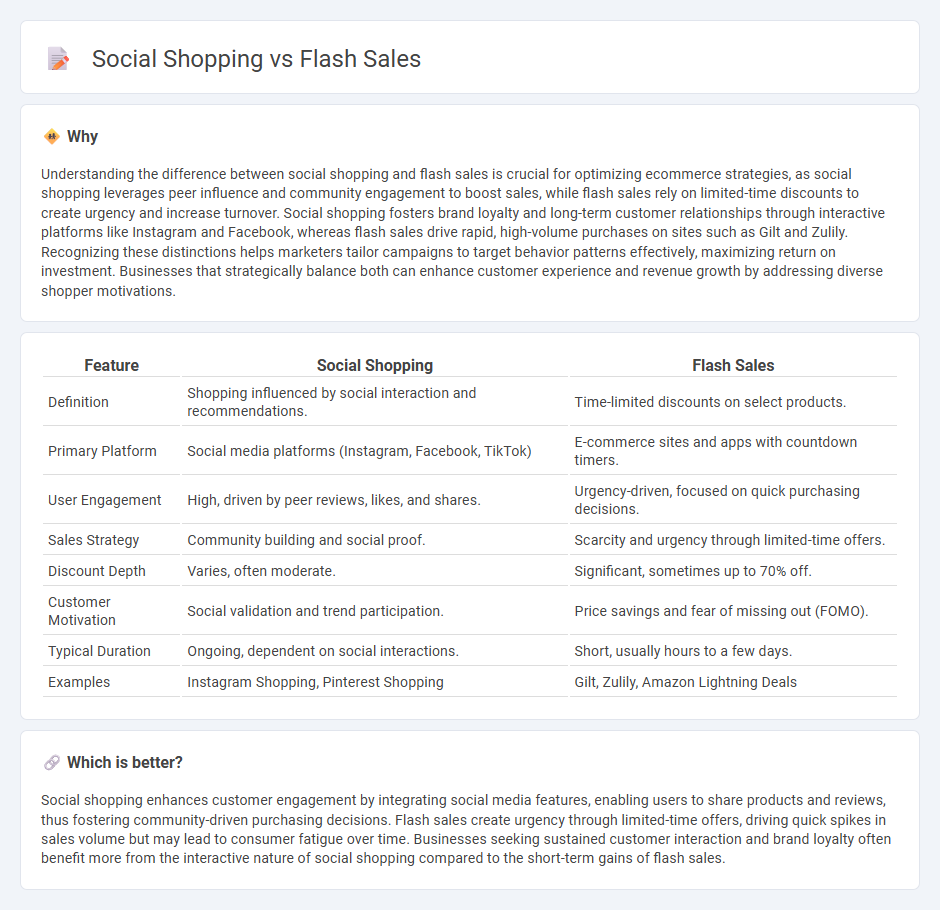
Social shopping leverages peer recommendations and interactive platforms to enhance the purchasing experience, fostering community-driven decisions and real-time feedback. Flash sales create urgency with limited-time offers, driving rapid transactions and inventory turnover through exclusive discounts. Explore more to understand how these strategies reshape consumer behavior and boost business growth.
Why it is important
Understanding the difference between social shopping and flash sales is crucial for optimizing ecommerce strategies, as social shopping leverages peer influence and community engagement to boost sales, while flash sales rely on limited-time discounts to create urgency and increase turnover. Social shopping fosters brand loyalty and long-term customer relationships through interactive platforms like Instagram and Facebook, whereas flash sales drive rapid, high-volume purchases on sites such as Gilt and Zulily. Recognizing these distinctions helps marketers tailor campaigns to target behavior patterns effectively, maximizing return on investment. Businesses that strategically balance both can enhance customer experience and revenue growth by addressing diverse shopper motivations.
Comparison Table
| Feature | Social Shopping | Flash Sales |
|---|---|---|
| Definition | Shopping influenced by social interaction and recommendations. | Time-limited discounts on select products. |
| Primary Platform | Social media platforms (Instagram, Facebook, TikTok) | E-commerce sites and apps with countdown timers. |
| User Engagement | High, driven by peer reviews, likes, and shares. | Urgency-driven, focused on quick purchasing decisions. |
| Sales Strategy | Community building and social proof. | Scarcity and urgency through limited-time offers. |
| Discount Depth | Varies, often moderate. | Significant, sometimes up to 70% off. |
| Customer Motivation | Social validation and trend participation. | Price savings and fear of missing out (FOMO). |
| Typical Duration | Ongoing, dependent on social interactions. | Short, usually hours to a few days. |
| Examples | Instagram Shopping, Pinterest Shopping | Gilt, Zulily, Amazon Lightning Deals |
Which is better?
Social shopping enhances customer engagement by integrating social media features, enabling users to share products and reviews, thus fostering community-driven purchasing decisions. Flash sales create urgency through limited-time offers, driving quick spikes in sales volume but may lead to consumer fatigue over time. Businesses seeking sustained customer interaction and brand loyalty often benefit more from the interactive nature of social shopping compared to the short-term gains of flash sales.
Connection
Social shopping leverages peer recommendations and social media platforms to create interactive buying experiences, driving real-time consumer engagement. Flash sales create urgency with limited-time offers, amplifying social shopping by encouraging users to share deals quickly within their networks. Together, they boost impulse purchases and increase visibility through social proof and time-sensitive incentives.
Key Terms
Limited-time Offers
Limited-time offers in flash sales drive urgency by providing steep discounts available only for brief periods, boosting immediate purchases and inventory turnover. Social shopping leverages these limited-time deals within community-driven platforms, enhancing engagement through shared recommendations and real-time interactions. Explore how combining flash sales with social shopping can maximize conversions and customer loyalty.
User-generated Content
Flash sales leverage urgency and limited-time offers to drive immediate purchases, while social shopping emphasizes community engagement and personalized experiences through user-generated content (UGC). UGC enhances trust and authenticity, influencing purchase decisions by showcasing real customer reviews, photos, and videos across social platforms. Explore how integrating flash sales with social shopping strategies can maximize customer engagement and conversion rates.
Social Proof
Social proof significantly boosts social shopping by leveraging user reviews, ratings, and peer recommendations to enhance trust and drive purchasing decisions. Unlike flash sales, which rely on scarcity and urgency, social shopping creates a community-driven experience that fosters long-term customer engagement through shared social validation. Discover how integrating social proof can amplify your e-commerce strategy and increase conversion rates.
Source and External Links
Flash Sale Definition Explained | Podbase Glossary - A flash sale is a short-term promotional event offering select products at deeply discounted prices for a limited time, designed to create urgency and encourage quick purchases, often lasting 24 to 48 hours and promoted through email, social media, and ads.
What Is A Flash Sale? How to Run One and Examples (2025) - Shopify - Flash sales are limited-time discounts that leverage fear of missing out (FOMO) to drive impulse buys, commonly used during major shopping events like Black Friday, helping businesses grow sales but requiring careful management to protect margins and reputation.
What are flash sales? - BigCommerce - Flash sales feature limited quantity and time-sensitive discounts that encourage immediate purchases, effective for quickly clearing excess or out-of-season inventory and helping reduce operating costs while boosting sales momentum in ecommerce.
 dowidth.com
dowidth.com